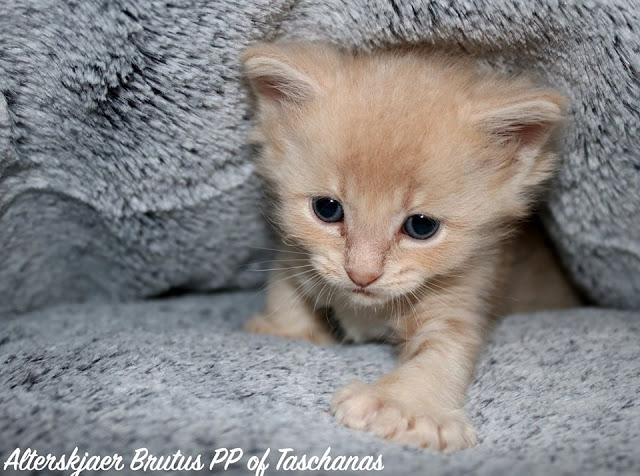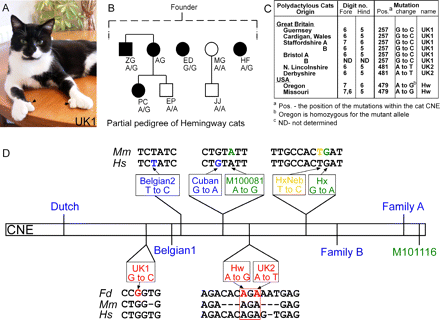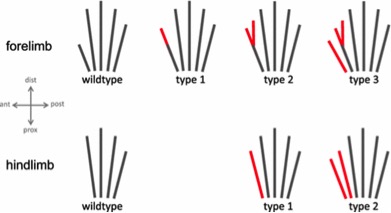THE GENETICS OF POLYDACTYLY IN MAINE COON CATS

Poly Maine coon kitten. Photo copyright: Monica A Sundset.
Summary
Polydactyly (extra toes) is a harmless anatomical anomali commonly seen in Maine coon cats (Fig 1). Polydactyly in Maine coon cats is caused by a single point mutation called the ”Hemingway mutation” (Hw) within the regulator gene ZRS. This gene is responsible for the expression of the gene Shh determining digit formation in paws (Lange et al. 2014). The Hw mutation results in different phenotypes and is very variable in expression (Lange et al. 2014; PolyTrak data collection). Cats with the Hw mutation may have up to 8 extra toes, they may have only an enlargement of the standard dew claw, or making it a thumb (so still 5 digits), or only one poly paw (6 digits). Hence, the expression of the polydactyly can be very minor (like only a nub) - or with several extra digits. They are often called "mitten" paws, because the extra “thumb” toes makes the paws look like mittens. Mutations resulting in polydactyly are inherited as an autosomal dominant trait with high penetrance (Danforth 1947; Lettice et al. 2008, Hamelin 2011), and can thus easily be selected against in breeding. A total of three mutations have been revealed so far in polydactyl cats: the Hw mutation in Maine coon and PixieBob cats, and the UK1 and UK2 mutations in British domestic short hair cats (Lettice et al. 2008, Lyons 2009). More mutations must exist, as Canadian lines of polydactyl Maine coon cats lack the Hw mutation and does not have the UK1 or UK2 mutation either (Hamelin 2011). Dr. Marie Abitbol and her coworkers at Lyon Veterinary School in France are currently working to reveal the mutation causing polydactyly in Maine coon cats from Canadian lines (personal communication). The mutation behind the "pattyfoot" (extra toes but no “thumb”) (Figure 1) also remains to be found.
This review was written as my “special project” on a chosen topic in the PawAcademy G2 course autumn 2018. Text updated January 2020.
Introduction
The Maine coon was accepted as a breed and given championship status by the Cat Fanciers’s Association (CFA) in 1976. More than 15 years later, in 1982, the breed was also recognized by the Fédération Internationale Féline (FIFe).
The Main coon cat is native to Maine, New England in Northern America. These cats evolved through natural selection developing all the characteristics of a good working cat. Maine coons are large, intelligent, skilled hunters, and they are well adapted to survive harsh coastal winter climates.
Polydactyly was and still is a common trait in the Maine coon breed. The word polydactyly arrives from the Greek word polydaktylos (poly = much, many, daktylos = finger) and describes the physical anomaly in humans and animals with extra fingers and / or toes as compared to the wildtype of the given species.
Polydactyl Maine coons originally contributed to a large proportion of the gene pool (40% according to The FIFe Breed Council MCO and Henning Mueller-Rech, 2011/2012), and polydactyl cats are consequently part of the pedigree of most of todays Maine coon cats. But the disqualification from shows has led to the exclusion of many polydactyl Maine coons from breeding. Polydactyly is inherited as an autosomal dominant trait with high penetrance (Danforth 1947; Lettice et al. 2008, Hamelin 2011), and can thus easily be selected against in breeding.
Polydactyly is not found in Maine coon cats alone. It is common in cats along the East Coast of North America (US and Canada), and also in Britian. Lloyd (1985) examined >5000 cats in 35 populations in East Canada and the northeastern United States and found that 0-8% of the cats in these different populations were polydactyl. The famous author Ernest Hemingway had close to 200 cats living with him between his two homes in Key West in Florida and in Cuba many of them polydactyl cats with six toes. Today 40-50 descendants from these cats still live in the Hemingway Home and Museum in Key West. In Norway, a polydactyl cat is often referred to as a ”skipskatt” (a ”ship cat”). These cats were considered to be ”lucky mascots” by sailors, who also considered these cats superior mouse and rat hunters (Harthwell 2001-2010).
Polydactyly pose no treat to the wellbeing of the cat (Lange et al. 2014, Hamelin et al. 2017) and should be considered an innocent phenotypic variant of the breed. In general, polydactyly is not a handicap and causes no ill effects in cats. Except that in rare cases nail growth may be affected. Overgrown claws are of course not only restricted to polydactyl cats, but the extra toe may be shorter and in slightly different directions than regular toes. Nevertheless – paws and claws of all cats – poly or not – should be looked properly after and claws clipped when necessary – as we do it for our dogs. The big paws of the polydactyl Maine coon cats are often compared to snowshoes and some argue that they facilitate walking on snow. The large paws are also thought to help the cat climb and hunt more efficiently.
Today, polydactyl Maine coons can be breed and registered within CFA, New Zealand Cat Fancy Inc. (NZCF), The International Cat Association (TICA), and the Cat Fanciers’s Federation (CFF). NZCF was the first to accept polydactyl Maine coon cats in the show ring, making it eligible for championship status alongside the regular-footed Maine coons (January 2009) (PolyTrack Newsletter 2009). TICA followed this example and has accepted Maine coon polydactyls for championship since May 2015 (TICA web page). FIFe has gone in the opposite direction and recently (Jan 2014) banned breeding and registering polydactyl Maine coon cats all together.
The genetics of polydactyly in cats
In the years before genetics started to expand as a research field, research on polydactyly had already gone on for >100 years with publications on polydactyly dated back all the way to 1861 (Lange and Müller 2017).
The first paper on the genetics of polydactyly in cats was published by Danforth in 1947. He studied inheritance in polydactylous cats through several generations to assess the frequency of extra digit formation.
Danforth bred polydactyl cats with polydactyl cats, polydactyl cats with non-polydactyl cats, and non-polydactyl cats with non-polydactyl cats. He found that in every mating where at least one of the parents was polydactyl, polydactyl cats would also appear among the offsprings, while in matings between normal-footed cats there was never any polydactyl offsprings. Danforth also found that in some of the matings all of the offsprings turned out to be polydactyl, and argued that this could be explained by one or both parents being homozygous for polydactyly.
Danforth (1947) concluded from his studies that polydactyly was caused by a variably expressed dominant gene, and he found no indication that this ”gene” was harmfull or lethal when homozygous.
Furthermore, Danforth (1947) found no evidence that polydactyly was associated with other anomalies such as split foot or radial hyplasia in his study of this largely in-bred population of 254 polydactyl kittens decending from two domestic long haired dams.
Polydactyly is caused by a single-point mutation in the regulatory gene ZRS
Today we know that polydactyly is not caused by a gene mutation (a ”Pd gene”) but rather a single point mutation in a regulatory element called ZRS responsible for the expression of the gene that determines digit formation in the paws of the cat (Lange et al 2014). This suggests that the nature of preaxial polydactyly in cats is similar to that of other mammals (mice and humans), producing limb-specific phenotypes but with no other physical or physiological defects.
Both Lange et al. (2014) and Hamelin et al. (2017) documents a large variability in the expression of polydactyly in cats, but concludes that these single point mutations have no apparent ill consequences for the animal welfare.
As explained above, polydactyly in domestic cats (and also in humans and mice) is caused by a single point mutation in a regulator gene called ZRS. ZRS is a long-distant, limb-specific cis-regulator for SHH (a signalling molecule called «Sonic Hedgehog»), and controls the expression of Shh in the developing limb bud, consequently regulating digit identity and number (Fig 2).

Fig 2. Single base pair (point) mutations in the regulatory gene ZRS have been shown to cause polydactylism, as they modulate Shh expression in the the limb buds (Zone of Polarizing Activity (ZPA)) and induces the formation of extra digits by ectopic expession of Shh (Lettice et al. 2003; figure reprinted from Lettice et al. 2012).
All together, Lettice et al. (2008) identified three novel mutations (single nucleotide substitutions) associated with preaxial polydactyly in the ZRS of North American and British cats (Fig 3). These are the only known mutations associated with polydactyly in cats so far.
The polydactyl Hemingway’s cats (Fig 3B) were either heterozygous (A/G) (n=3) or homozygous (G/G) (n=1). The homozygous cat did not show a more severe phenotype and was polydactylous only on the forelimbs. The other American cats included in this study by Lettice et al. (2008) (Fig 3C) had the same mutation as the Hemingway’s cats suggesting that there is a common allele in polydactylous cats in North America, while the British cats did not have the Hw mutation. Instead the British cats (n=8) were found to have mutations in position 257 and 481 (UK1 and UK2) (Fig 3C and D).

Fig 3. Figure and genetic analysis of polydactylous cats and their mutations reprinted from Lettice et al. (2008). A shows a polydactylous cat carrying the UK1 mutation (at position 257) with extra digits on her fore paws. B shows a partial pedigree of the Hemingway cats sampled in the study all of them presumably derived from a single founder. Affected cats are depicted with solid squares (males) and circles (females). The initials for each cat are shown and their genotype is shown below the initials. The wild-type allele has an A at position 481 of the cat sequence, and the mutant allele a G. C shows a list of the polydactylous cats from Great Britain and the USA showing the origin of each, the limb phenotype and mutation that was determined at positions 257 (UK1) and 481 (UK2) in the British cats and at postition 479 (Hw) in the US cats. D shows a summary of 12 mutations in the ∼800 bp conserved non-coding element (CNE, which is a conserved part / segment in the regulatory gene ZRS). The relative position of the cat mutations are shown in red below the CNE together with the corresponding sequence in mice and humans (Fd, Felis domesticus; Mm, Mus musculus; and Hs, Homo sapiens). Other mutations used in the analysis are shown above the CNE (mutations identified in Hs are indicated in blue while Mm mutations are in green).
Genetic testing for polydactyly in cats
DNA testing for diseases and phenotypes is a rapidly growing asset for cat breeders world wide, and there are many commercial laboratories and tests available. Optimal Selection (MyCatDNA) test for polydactyly based on the three known genetic markers / mutations identified by Lettice et al. (2008).
LIMBR1: c.A479G
The singel point mutation c.A479G is referred to as mutation Hw by Lettice et al. (2008) (Figure 3) and is also called the «Hemingway mutation». Cats with this mutation have between 2 and 8 extra digits / toes. This mutation has been identified in Maine Coon cats (Lettice et al. 2008) and i PixieBob cats (Lyons 2009).
LIMBR1: c.A481T and LIMBR1: c.G257C (referred to as muttion UK2 and UK1)
Both of these single point mutations, effecting gene Shh, were identified in domestic short hair cats by Lettice et al. (2008) (Figure 3).
The Hw mutation is not forelimb specific as initially suggested
Lange et al. (2008) reported the cat Hw mutation to be forelimb specific, and stated that the Hemingway’s cats are affected primarily on the forelimbs (about 80% of the affected cats show polydactyly on the forepaws only, with reference to personal communication with Kirsten Jensen, DVM, Key West, Florida who sampled the Hemingway cats at the Hemingway House), while cats carrying the UK2 mutation had extra digits on all paws. Likevise, Lettice et al. (2008) describes an exclusive forelimb effect of the Hw mutants amounting to 80% of the cases.
Our Maine Coon cat, Bellona, was tested for all three known mutation variants, and tested positive for the «Hemingway mutation» (being heterozygous Hw/N) at position 479 of the ZRS. Her DNA screening results are public and are available online. Bellona is born with two extra toes on each of her front paws and one extra toe on each of her back paws (7-7-5-5), 24 toes in total. Hence, Bellona's Hw effected all four paws and this same pattern of toes is found in her father Elders and grandmother Bluebell - while her brother Bertha is the wildtype (N/N) with 6 and 7 toes on his front paws and 5 on each of his back paws (Fig 4).

Fig 4. Partial pedigree for our polydactyl Maine coon cat, Taschanas Goddess Bellona PP. She is heterozygous for the "Hemingway mutation" (Hw/N), and is born with two extra toes on each of her front paws and one extra toe on each of her back paws (7-7-5-5), 24 toes in total. Bellonas brother (Bertha), father (Elders) and grandmother (Bluebell) are polydactyl. Her other brother (Bast), mother (Karisma) and grandfather (Zack) are wildtypes with 18 toes. Polydactyl cats are depicted within black squares (males) and circles (females), wild-type cats (N/N) within white squares (males) and circles (females). Photos by Marita R. Sørensen / Taschanas, Johanna Eli Forssblad / Lynx Luna, Sofie Gonzales, Monica Alterskjær Sundset / Alterskjær.
A recent study by Lange et al. (2014) showed that among the 378 polydactylous Hw mutant cats that he tested in this study, only 47% of the polydactyl phenotypes were restricted to the forelimbs. In fact, the Hw single point mutation in Maine coon cats was found to result in many different phenotypes and up to eight extra toes (Fig 5-6) (Lange et al. 2014). Cats may also have a «dewclaw» (a soft tissue appendage with a claw lacking internal skeletal elements).

Fig 5. The frequency of symmetrical polydactylous toes in cats (n=375) with the Hw is stable, the more toes the lower the frequency. Number of toes on all four limbs are shown above the columns. The most common pattern among the Hw mutants is 6-6-4-4. The wildtype cats have 5-5-4-4 toes, 18 in total. Rare asymetrical polydactylies are not included in the table. PPD = preaxial polydactyly, 5P = three-phalangeal thumb. Figure reprinted from Lange et al. (2014).

More mutations remains to be discovered in relation to polydactyly in cats
The mutation behind the "pattyfoot" (extra toes but no “thumb”) (Figure 1) still remains to be found. Furthermore, Hamelin (2011) in his PhD project detected the Hw mutation in all polydactyl Maine coon cats included in his study but not in the cats from Canadian lines. Importantly, Hamelin and co-workers also excluded the presence of any other mutation in the ZRS or neighboring DNA regions in these Canadian cats. This prompts the question that mutations must exist also outside the regulating gene ZRS, that can cause polydactyly in cats. Dr. Marie Abitbol and her coworkers at Lyon Veterinary School in France are currently working to reveal this second unknown mutation in the Canadian lines (personal communication).
References
Hamelin A (2011) La Polydactylousie du Maine Coon. École Nationale Vétérinaire d’Alfort. Dissertation
Hamelin A, Begon D, Conchou F,Fusellier M, Abitbol M (2017) Clinical characterization of polydactyly in Maine coon cats. Journal of Feline Medicine and Surgery 19: 382-393.
Harthwell S (2001-2010) Polydactyl cats (Part 1).
Lange A, Nemeschkal HL, Müller GB (2014) Biased polyphenism in polydactylous cats carrying a single point mutation: the Hemingway model for digit novelty. Evolutionary Biology 41:262–275.
Lange A, Müller GB (2017) Polydactyly in development, inheritance, and evolution. The Quarterly Review of Biology 92(1).
Lettice LA, Heaney SJH, Prudie LA,Li L, de Beer P, Oostra BA, Goode D, Elgar G, Hill RE, Gde Graaff E (2003) A long-range Shh enhancer regulates expression in the developing limb and fin and is associated with preaxial polydactyly. Human Molecular Genetics 12: 1725-1735
Lettice LA, Hill AE, Devenney PS,Hill RE (2008) Point mutations in a distant sonic hedgehog cis-regulator generate a variable regulatory output responsible for preaxial polydactyly. Human Molecular Genetics 17:978-985
Lettice LA, Williamson I, WiltshireJH, Peluso S, Devenney PS, Hill AE, Essafi A, Hagman J, Mort R, Grimes G,DeAngelis CL, Hill RE (2012) Opposing functions of the ETS factor family define Shh spatial expression in lim buds and underlie polydactyly. Developmental cell 22: 459-467
Lloyd AT (1985) Geopgraphic distribution of mutant alleles in domestic cat populations of New England and Canadian Maritimes. Journal of Biogeography 12: 315-322
Lyons LA (2009) Recent advances in cat genetics. CAB Reviews: Perspectives in Agriculture, Veterinary Science, Nutrition and Natural Resources 4 (018): 1-14
Optimal Selection (MyCatDNA) – online information about their feline genetic breeding analysis.
The PolyTrak Newsletter – Paws forEffect (2009) NZCF first major cat association in the world to accept the Maine coon poly! 3(1): 3
The FIFe Breed Council MCO andHenning Mueller-Rech, Feb 2011/Feb 2012, The Maine coon standard in FIFe in history and present
TICA on the Maine Coon Polydactyl










